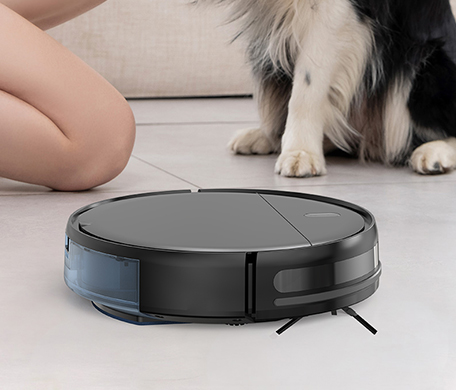For those who clean the house, bending down to clean every day can be a super tiring and demanding task. Fortunately, there is the smart cleaning robot to rescue us and help us embark on a smart life by freeing our hands.
The smart cleaning robot is controlled by a microcomputer and is capable of automatic navigation and cleaning of the ground, including sweeping and vacuuming. It can avoid and bypass obstacles in its path through its collision head technology, as well as clean every corner with its two large side brushes. The two brushes rotate relative to each other to prevent garbage from slipping out of the bottom of the robot and to achieve more thorough cleaning. The combined sweeping and vacuuming action makes it easier for dust and dirt to enter the garbage collection box in a regular and smooth manner. Furthermore, the robot has a built-in photoelectric sensor in the front wheel and cleaning wheel power box, which allows it to automatically recognize when it's stuck and prevent jamming. Finally, the infrared reflective detector on the collision head can automatically detect when the robot is approaching a cliff, and the robot will automatically steer clear.
One of the advantages of the smart cleaning robot is that it can intelligently simulate human cleaning patterns, cleaning hair, small debris, dust, paper and other objects from the ground. The scope of the smart cleaning robot is quite broad and can clean ceramic tiles, solid wood floors, composite wood floors, marble, carpets and more.
Most of the current floor cleaners on the market adopt a random sweeping mode to cover a high area, but good quality smart cleaning robots can sense the amount of dust and adjust their cleaning mode accordingly to achieve a more efficient and quicker cleaning result. The latest smart cleaning robots have automatic mapping capabilities and can connect to a mobile app via WiFi, enabling you to see where the robot has and has not cleaned, making it easier to monitor and use.
Charging batteries: Generally, nickel-hydrogen batteries are the main type used, but some robots use lithium batteries, which offer good power storage capability.
Dustbin: There are roughly two types of dustbin: central and rear
Remote control: Smart cleaning robots come with two types of control, one is owned by the robot body, and the other is a remote control which is relatively high-end.
Ultrasonic bionic technology: This type of sensor detects and determines home items and spatial orientation through sound waves, and has high sensitivity. Some high-end products have this function.
Body: To prevent collisions, most manufacturers of the smart cleaning robot design their products in a circular shape.
Sensor: The infrared transmission distance can detect obstacles, and most smart cleaning robots have this feature.


